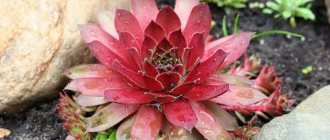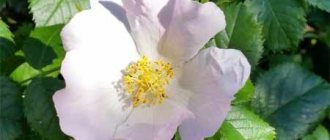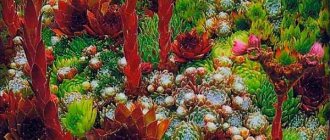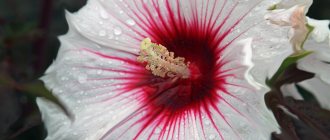Stone rose (juvenile) has a reputation as a very tenacious and unpretentious plant. Even its Latin name, Sempervivum, translates as “always alive.” This reputation is mainly based on the fact that the stone rose, regardless of the conditions and time of year, always remains green, easily tolerates frost, and produces numerous offspring. And if we add to these features all the properties of succulents, which is what Juvenile is, then we can assume that this reputation is completely justified.
But at the same time, you shouldn’t relax too much. The stone rose is still a flower, a living organism, and requires care, both at home and in the open ground.
A little about the plant
Stone rose has been grown as a cultivated plant for a very, very long time. The range of its application is also very wide. It was used as a roofing material, in the belief that the young plant protected against lightning strikes. How effective this protection was is unknown, but this “tile” protected perfectly from rain and other precipitation. One of the names for the young is Hare Cabbage. And this “cabbage” was eaten. Moreover, it was believed that it has unique properties that restore youth (hence the name “Molodilo”). The plant may not return youth, but the medicinal properties of the stone rose are undeniable. Juvenile ointment was used in ancient times to heal wounds, and in folk and official medicine drugs are prepared from it for the treatment of heart failure and epilepsy. And, of course, the young were and are being grown for decorative purposes. It can be planted as a ground cover plant, which will create a dense, bright carpet on the site. You can plant it as a border plant, decorate a flower bed or rock garden, or you can create an original sculpture or sculptural group. The young are also grown at home, as a houseplant.
According to the botanical classification, the stone rose belongs to the Crassulaceae family and has about 50 species. But it is quite difficult to distinguish them without deep knowledge of the subject. Even plants of the same species can differ strikingly in both shape and color. The most suitable species for growing in open ground in the middle zone is Molodil Russian.
Introduction to the stone flower
In the 19th century, a book was published called "Flora of Mexico" with illustrations by the artist Anastasio Eccheverria. Of the variety of flowers, a flower resembling a stone rose turned out to be very noticeable and unusual. This is how the plant received its botanical name - echeveria (eccheveria).
Features of Echeveria - stone rose.
Echeveria is also called stone flower or stone rose, due to its neat round rosette of leaves that have different shapes and varied colors. The plant belongs to the genus of succulents and the Crassulaceae family. Its leaves are in the form of a low rosette, the diameter of which is 5-30 cm. In the wild, there are approximately 200 species of echeveria, differing only in the shape and covering of the leaves.
The rosette may consist of flat or convex leaves, have a waxy coating or fluff, with the help of which the plant is protected from sunlight and winter frosts. You can often find a stone rose with purple leaves.
Since the plant first appeared in Mexico, which has many bright and sunny days a year, wild echeveria species have short stems. If you grow a plant indoors, it, deprived of sufficient lighting, stretches out and becomes less decorative.
A related plant, Juvenile, which is common in Europe, the Caucasus and Asia, is often mistaken for echeveria. It is also called stone rose and the plants are very similar in appearance. Juvenile is more frost-resistant, so it is not even grown indoors. Echeveria can die if the air temperature is below 6 degrees above zero. In addition, juveniles do not have stems.
Description of the plant
The second name of the plant is stone rose.
It is an evergreen perennial succulent plant.
Photo of the plant Molodilo
If we literally translate the name of the plant Sempervivum from Latin, we get “always alive.”
Molodilo lives up to its name with its amazing vitality. The stone rose comes from the Sedum genus. The foliage shape of this fleshy herbaceous plant can be sharp, elongated or round. There are species whose foliage surface exhibits hairiness.
Externally, the Sempervivum plant really resembles an open rosebud. The petals of the young are fleshy, sometimes have a border in the form of cilia. The diameter of the flower can reach 5-15 cm.
The most beautiful unpretentious perennial - young - video
You will be pleased with the flowering of young ones only after 3 years of age. The flowering period of the young will last about 30-60 days. A massive peduncle in the form of a brush will appear from the rosette, on which red or yellow flowers will form. The shape of the flowers resembles stars. Immediately after flowering, the leaf rosette dies. But a significant number of young “survivors” are growing up to replace her.
Varieties of rock rose
There are, as mentioned above, about 200 species of echeveria. If we consider miniature plant species with a stem less than 10 cm long, the most common varieties are:
- Echeveria graceful, which has a light green rosette of leaves and a peduncle, the flowers of which are red-yellow.
- Echeveria Derenberg produces beautiful orange flowers and leaves with red edges.
- Echeveria bristlecone is a miniature plant with leaves covered with white bristles.
Varieties and types of stone flower.
The varieties of the most common tall-stemmed rock roses are as follows:
- Echeveria is purple, has a strong stem, at the very top of which you can see a rosette collected with pubescent leaves. The flowers are red, with yellow edges.
- Echeveria hump-flowered is distinguished by a strong stem, the growth of which is up to 65 cm.
- The most frost-resistant is Echeveria blue.
In addition to the listed plant species, nature and people have created many other types of stone roses that are beautiful in shape and color.
Types of flower rejuvenated
Roofing
We have already looked at roofing. This is the most common type. The calyxes are spherical, varying in size from five to twenty centimeters. It is green in color with red edges.
Cobwebby
This flower has its name for a reason. At the tips of tiny rosettes, only 3 centimeters in size, thin fibers grow, reminiscent of a cobweb. Mainly lives in mountainous areas.
Russian
The main habitat is central Russia. Medium rosettes up to 7-8 centimeters with long leaves, painted bright green. The tips of the rosettes have a red tint. The flowering period occurs in the second half of summer.
Pobegonosnoe
Grows in Russia and Europe. The six-centimeter cups are colored red and green. It blooms with yellow flowers for about two months in mid-summer.
spherical
This species is found in the Caucasus Mountains. The shape of the rosette resembles green balls measuring five centimeters.
Caucasian
It has small purple cups with sharp tips. Blooms in the second half of summer.
Gornoe
The smallest rosettes are no more than one to two centimeters. At the beginning of summer it blooms with unusual purple flowers.
Conditions for normal development and growth of echeveria
With proper care, it is necessary to provide the following conditions for the plant:
- Lighting. At any time of the year there should be enough bright light and direct rays of the sun. It is not advisable to place pots with plants on window sills facing north.
- Glaze. In winter and autumn, you need to water the plant moderately, once a month. In spring and summer, water it more often - when the earthen ball dries out completely. It turns out once every 10 days.
- Air humidity. Spraying the outlet is not required at any time of the year.
- Temperatures. In winter and autumn, the air temperature in a cool room should not fall below +10 degrees. In summer and spring, the temperature should be 22-27 degrees above zero.
Features of the correct growth and development of a stone rose.
Reviews
Alexandra. “The variety is very persistent and unpretentious. After the purchase, I quickly got used to the conditions in the apartment and the new type of watering (switched to a wick). The first flowering was very pleasing. The flowers were immediately large, but it produced only two peduncles of 3 flowers each. The second time there were a lot of flower stalks, but it was either hot or there were a lot of buds, but the flowers became a little smaller.
Marble rose is a very simple variety to propagate. I practice only leaf cuttings (stepchildren spoil the appearance of the rosette; seeds and flower stalks are very difficult). I had 2-4 children on each sheet, which made me very happy.”
Igor Sergeevich. “This variety has proven itself very well. Despite the lack of special care, the rosette is very beautiful, and the flowers are large and fluffy. I just started propagating, I put the leaves in moss on a wick, the first roots have already appeared. For three years now I have been trying to get cap flowering from it, but so far without success. It’s important to me that the Marble Rose is not afraid of heat, because in my summer it’s very hot and a lot of Saintpaulias just disappear.”
This variety has captivated many gardeners with its beauty.
Planting and replanting stone roses
When purchasing plants, try to ensure that the bushes you buy are healthy, the rosettes are compact, so that the plants are not elongated and do not suffer from any disease. Since the bulk of the plants are grown by sellers in a peat mixture, it is recommended to replant newly purchased echeveria immediately into loose and light soil for succulents.
Echeveria has a shallow root system, so you should not use deep pots to grow it - a wide, flat container will do. The bottom of the container should have enough drainage holes and a drainage layer that includes pebbles, broken bricks or expanded clay. The layer should not be less than 2 cm thick.
For growing the plant, light soil for cacti and succulents is most suitable. It is allowed to prepare the soil with your own hands. To do this, mix the following composition:
- Sod land - 3 parts.
- Sand – 1 part.
- Small expanded clay – 1 part.
Before planting echeveria, it is necessary to disinfect the soil. This can be done by pouring boiling water over it and then cooling. Young plants are replanted every spring. The same soil is used, but replanting is done in wider pots (a couple of centimeters wider).
How to plant and replant a stone rose.
By replanting, you can also start propagating the plant. This is done by cutting off the lateral daughter rosettes and mature leaf blades.
Violet Marble Rose (S. Farbitnik)
Fascinating violet Marble rose.
Marble rose is a violet of Usambor, genus Saintpaulia hybrid, family Gesneriev, class dicotyledonous, division flowering. The variety was bred by Sofia Farbitnik .
The rosette is standard size, about 25-28 cm in diameter. Sheets:
- Very dark, green shade;
- Glossy;
- Round with a heart-shaped base.
Flowering is abundant, but gradual. There are usually a lot of peduncles , and there are also buds on them, but before the next flower opens, the previous one begins to fade.
The color is fancy, the flowers are double and semi-double. The main tone is white and pink with a crimson-red marble pattern.
The size of the flowers is large, up to 7 cm, but the more abundant the flowering, the smaller they are.
The variety is resistant to difficult conditions , and even in the heat it blooms successfully, producing 2-3 peduncles with a bunch of buds. The variety is not slow to grow, but the young plant requires attention.
Attention! The first flowering is usually sparse and reaches its maximum extent at least by the third time.
Florarium decoration
A beautiful and original composition can be created using several miniature succulents in a florarium. It can be created independently or purchased ready-made. The composition can be composed of various types of echeveria, cacti, Kalanchoe, young plants and other plants.
Work on creating a composition is carried out in the following order:
- First, the glass container is disinfected with alcohol.
- Fine drainage is poured onto the bottom of the container in a layer a quarter of its height, on top - a layer of soil of the same thickness, lightly compact both layers.
- It is imperative to have a drainage layer at the bottom of the container, even if it is small and small plants are planted.
- Next, plants are placed on the ground, the roots of which are lightly sprinkled with soil, which is carefully compacted.
- Pre-boiled and cooled decorative pebbles and sand are laid out on the ground (colored sand will look more beautiful). You can also put special stones for the aquarium.
- If the top layer of the florarium will be soil for the aquarium, it is better to use colored soil - it will turn out very beautiful.
- All that remains is to decorate the composition by installing figurines or floral decorative elements.
Decorating a florarium using a stone rose.
The place for the florarium should be brightly lit. The composition should be watered rarely, even less often than an echeveria growing in an open pot is watered; the soil should not become waterlogged.
If the container and soil are not disinfected, the plants may be affected by fungal infections, which quickly develop in the limited space of the florarium.
Growing a flower in open ground
Initially, young was an open ground plant, so it is freely grown in flower beds, rock gardens, alpine hills, and also in various flowerpots in the country.
How to plant a stone rose (seeds and vegetatively)
In open ground, sowing can be done when the soil warms up to 20 °C, only then after 14 days will seedlings appear. Since young seedlings are very small in size and grow extremely slowly, the seed method for open ground is rarely used, giving preference to cutting and planting daughter rosettes. Rooting usually takes only 2 weeks.
Stone rose seedlings
Note! The best time for sowing seeds is June, and for planting rosettes cut from an adult plant, late spring, all summer and even September are suitable.
Selecting a location
The place for the stony rose should be illuminated throughout the day. It is best to choose an elevated site to eliminate the possibility of moisture accumulating at the roots.
How to prepare the soil and flower for planting
Loose soil containing little humus is suitable for planting. It is best to additionally add sand and crushed charcoal for better aeration. The sockets themselves do not require preliminary preparation.
Step by step landing procedure
The order of planting sockets is as follows:
- Using a sharp knife, cut the young rosettes from the mother plant, leaving a petiole 5-10 mm long.
- Immediately prepare the site for planting by thoroughly loosening the soil on it.
- Plant rosettes, leaving 10-15 cm between them.
- Water the rose stone very carefully to only slightly moisten the soil. The next watering is needed no earlier than 7 days later.
How to properly care for a stone rose
Echeveria is a rather finicky plant that requires special care.
Optimal lighting and temperature values
The most important factor for normal growth and development of plants is a sufficient amount of sunlight. The stone rose must receive a lot of light in summer and winter, otherwise it will cease to be an ornamental plant.
Proper care of a stone rose.
But air temperature is not a very important parameter for echeveria. In winter, it is better that the temperature is no higher than +15 degrees, however, lower temperatures are also allowed, but not less than 6 degrees above zero.
In the summer, take the plant to the balcony so that it stands in direct sunlight - echeveria is not afraid of burns, since it is protected by a waxy coating or pubescence of the leaves.
How to properly water and fertilize echeveria
Feeding the stone rose is carried out once a month in spring and summer. For this purpose, special fertilizers for cacti and succulents , which are applied according to the instructions. In the autumn and winter seasons, fertilizing is not done.
In summer, echeveria requires frequent watering. It is advisable to use the bottom watering method using a tray. It is not recommended to get liquid on the leaves.
In winter, when the room temperature drops and the plants do not receive enough sunlight, watering is reduced - no more than once a month.
Home and garden care
Before planting a plant or buying seeds, you should learn about all the nuances of care that are typical for your home or garden. In this case, you can avoid most complications that can kill the flower.
The most common mistakes in flower care are characterized by excessive care, which manifests itself in abundant feeding or watering. It should be noted that excessively fertile soil also negatively affects the plant.
Many gardeners recommend the so-called “Spartan” method of flower care, because succulents can independently nourish themselves with the necessary substances that have a good effect on their growth. In addition, they are able to make some reserves in their leaves.
Despite popular belief, anyone can grow a rock rose as a houseplant, but special care must be taken. In the case when the young are planted in a pot, various types of substrate can be used for it.
Watering and spraying
A distinctive feature of the stone rose is its cumulative effect, which allows you to make preliminary reserves of nutrients and liquid. Based on this, the plant does not require abundant watering. At the same time, too frequent watering can harm the flower and, if the drainage system does not effectively fulfill its role, the rose will die after some time.
The plant does not require frequent watering, 2 times a month is enough. In this case, you should avoid getting moisture on the leaves of the plant.
Despite popular belief, spraying is not a necessary aspect of growing, since the plant prefers low soil and air humidity.
Temperature
It is recommended to bring heat-loving plant varieties from the garden and place them in a cooler place. In this form they should be placed until spring, while watering can be reduced to 1-2 times every 1-2 months. You should also avoid getting excess moisture on the leaves.
Plants that are in the garden most often do not need any special care. If the stone rose variety is frost-resistant, it can easily overwinter in a layer of snow. If there is no snow cover, you can cover some sockets with improvised protection from plastic bottles.
In addition to plastic, shelter can be made from various materials. In this case, straw or pine spruce branches are suitable, which are carefully poured on top of the plant. If there is windy weather, you can use plastic film or agrofibre to cover the straw.
Transfer
Small stone rose sprouts need to be replanted once a year, adults - once every 5 years. The transplantation process should be carried out in the spring, which has the best effect on the plant.
Since the rose's root system grows closer to the surface, it must be planted in shallow flowerpots. Despite the fact that the pot can be made from different materials, it is best to use a ceramic or clay product.
Be sure to put a thick layer of drainage at the bottom of the pot, which can be expanded clay, clay shards or pebbles. It is recommended to place stones around the roots immersed in the ground, which will additionally saturate the plant with oxygen.
Priming
Stone rose especially needs loose soil, which has a neutral reaction.
In this case, it is best to use a store-bought substrate that is used for succulents, to which you can add the following ingredients in a 1:1 proportion:
- gravel;
- expanded clay;
- brick chips;
- sand.
In addition to the substances described above, many professionals recommend adding charcoal in order to protect the plant from root rot. It is advisable to decorate the free area around the plant with small stones, which can remove excess moisture from the soil.
If planting in the garden, you should pay attention to the fact that the area is rocky or sandy. Juveniles can also be planted in alumina, which contains small stones.
Feeding and fertilizer
Before the plant has reached 3 years old, it does not need to be fed. In the future, in order to maintain the natural and healthy appearance of the stone rose, you should add useful elements every 3 weeks, which should only be done during the growing season.
The most commonly used fertilizers are those used for cacti, which are diluted 2 times.
Also, for juveniles, various fertilizers intended for the root system can be used. If a gardener applies fertilizers that require spraying the leaves, if the required volume is exceeded, the foliage may disintegrate. In this case, the use of various fertilizers is stopped.
Pruning and crown formation
Pruning is one of the necessary conditions in order to grow a beautiful stone rose. This feature is important both for domestic plants and for those that grow in open ground.
Also, the process of pruning allows you to rejuvenate the rose. In addition, pruning makes it possible to add an aesthetic and decoratively pleasing appearance. Despite popular belief, the procedure is not dangerous and does not damage the plant in any way.
Pruning young shoots can be done using ordinary household scissors. If such a process is done for aesthetic purposes, you should acquire a specialized device.
In gardening practice, there are several types of pruning, each of which differs based on the purpose of use:
| Trimming type | Description |
| Formative | This pruning is done almost immediately after planting or replanting the plant. It is used to form a beautiful crown of the future bush. It also allows you to remove damaged or deformed branches and maintain the shape of the main crown. |
| Formation of a trunk | This type of pruning is done when the stone rose has gained strength or when a beautiful crown is formed. It is characterized by the removal of branched shoots, while the main trunk is not trimmed, which is necessary for its proper growth. To properly form the foliage, the specialist leaves only those shoots that have good strength. |
| Supportive | This pruning takes place only when the foliage is already formed. If this process is not carried out in a timely manner, the stone rose may not be suitable for decoration. In the case where the formation of the crown is characterized by errors on the part of the gardener, they can be corrected by completely eliminating unwanted branches. |
| Rejuvenating | This type of pruning is necessary in order to rejuvenate the plant. It is characterized by the removal of old or stunted branches, while young shoots are shortened. Such pruning promotes the correct formation of foliage. |
In addition to the above types of pruning, in practice the hygienic type is often used, which is characterized by the elimination of diseased, old or dried out shoots. This pruning is best done during flowering.
Dormancy and flowering periods
Echeveria does not have a dormant period; the plant simply slows down its growth in the winter. If you want to stimulate flowering, you can give the stone rose a rest in the autumn-winter period - put the plants in a cool room and do not water them.
Does the stone rose bloom?
Echeveria blooms most often in the summer. It produces one or more peduncles, the flowers of which are bell-shaped. If you do not want to collect seeds, it is recommended to remove the flower stalk after the plant has finished flowering, otherwise the flower will become depleted.
The beauty of sempervivum flowers
The stone rose is popular due to the decorative nature of its leaves, but it also blooms beautifully. True, each rosette blooms only once in its life. During flowering, it gradually dries out and eventually dies. In its place, children grow up and rejuvenation occurs. When purchasing new species, you should purchase young specimens, since young ones that are more than 3 years old bloom.
The tenacious flowers are graceful, beautiful, varied in color and shape. They bloom for a long time - almost all summer. The testes also have a spectacular appearance. The fruit consists of 8 to 20 multi-seeded leaflets covered with glandular fibers.
Large adult sempervivums may not bloom. But you can see the flowering of young plants. The fact is that stone roses begin to bloom due to unfavorable conditions and stress - if they become cramped, have nowhere to grow, with strong shading.
By planting young plants densely, you can cause increased flowering.
Mistakes when caring for a plant
Improper care of echeveria leads to errors that need to be eliminated.
With a lack of lighting: the shoots stretch out, the decorative effect is lost. To correct this drawback, you need to place the plant on a bright windowsill and illuminate it with fluorescent lamps or phytolamps.
With a lack of moisture: the leaves begin to wither and wrinkle. It is necessary to increase watering.
As the plant ages, the lower leaves begin to turn yellow. This is a natural process for the flower - the dried lower leaves are simply removed.
With excess moisture: leaves become swollen, yellow and watery. It is urgent to inspect the roots of the plant and the soil, transplant the echeveria into another soil, which should be air-intensive, and adjust the watering.
Rules of care
Every gardener, and just ordinary gardeners, love to decorate their flower beds with beautiful, special and unusual plants.
Kinds:
- Lisianthus;
- Eustoma;
- Prairie gentian;
- Texas Bluebell;
- Irish rose.
Lisianthus is a wonderful choice for any summer resident or gardener if he wants bright, variegated flowers with an eccentric arrangement of spots to grow in his flowerbed. Eustoma is a 70 cm tall flower that grows in meadows and fields.
It has strong stems that have many branches, and the leaves are long, round in shape, and bluish-green in color.
This flower is native to America and Mexico. But, at home, this flower grows no more than 50 cm. In general, eustoma is considered an annual plant, but experienced gardeners who know a lot about their business manage to create such comfortable conditions that the flower grows the next year.
Control of diseases and pests of stone rose
Echeveria is rarely affected by pests. However, it happens that the plant is affected by mealybugs, which damage the leaf blades and eat up the root system. The pest is easy to recognize - its colonies look like dirty cotton wool on the leaves of the plant.
They are removed using alcohol-soaked cotton swabs. You can wash off the pests with soap suds. If the case is complex and neglected, the plant and soil are sprayed with insecticides - Aktara and Fitoverm are most often used.
When a succulent is waterlogged or the soil is affected by a fungal infection , the plant withers and rots. You can get rid of this disease only at the beginning of infection. The drugs Fitosporin or Trichodermin, used strictly according to the instructions, will help with this. However, the disease is detected late, when it can no longer be saved.
How does echeveria reproduce?
The simplest and most reliable way to propagate echeveria is to separate the lateral daughter rosettes from the mother bush. This is done during plant transplantation in the spring. The rosettes are cut with a knife, which must first be sterilized, then each cut must be sprinkled with activated carbon powder, dried and planted in the ground the next day.
Rules and features of stone rose propagation.
Rejuvenation in landscape design
There is probably no better use for young animals than an alpine slide. Very often they decorate rockeries (slides made of stones). It is good to plant this perennial along garden paths. Decorating roofs with rejuvenated roofs, for example, in gazebos, has again become relevant.
Stone rose in landscape design
The plant will be appropriate in flower beds and flowerpots. The main thing that landscape design experts recommend is to complement the composition with stones. They will add integrity and completeness to your idea.
The variety of species of juveniles and its simple care allow even inexperienced summer residents to easily experiment with the design of their site. And what could be more enjoyable than creating beauty with your own hands!
Propagation using leaf or apical cuttings
When, for various reasons, a stone rose does not produce children, it can propagate using cuttings: apical or leaf. Actions are performed in the following sequence:
- A young leaf located close to the trunk is cut off from the mother bush, or the top of the stem is cut off, and several leaves located at the bottom of the stem are removed.
- The cuttings are dried for several hours.
- Then the lower part of the leaf or stem cutting is immersed in a moistened mixture of vermiculite and sand.
- The cutting is installed in a place that is brightly lit. The soil is periodically sprayed.
- A month later, after the roots appear, new rosettes develop.
- This process takes from 2 to 3 months. During this period of time, wrinkling and drying of the mother leaf occurs.
- The grown young rosette is transplanted into a wide pot filled with soil for cacti.
Reproduction was young with rosettes
The main way to obtain new specimens of stone roses is through children. It allows you to grow proven varieties. Most flower species reproduce independently and very quickly. You don't even need to make an effort to do this. But you can speed up this process. The young will develop faster in a sunny place.
Reproduction with the help of children is divided into two groups:
- Varieties that produce mustaches.
- Species without long shoots.
In the first group, each whisker has a small rosette at the end. To reproduce young of this type, you need to quickly root the baby. If there is free space near the mother plant, loosen the soil nearby, press the rosette tightly and sprinkle the tendril with soil. After this, carefully water it. New sempervivums take root and grow quickly. In the future, the grown rosettes can be planted. They should be replanted together with the shoots.
If the mother flowers are located too close to each other and there is no room for rooting, allow the rosette at the end of the tendril to grow and separate it from the old plant. At the same time, make sure that the main part of the process remains with the baby. This is important because they will become tap roots in the future. If they are not left, the young will grow more slowly. The seedlings are planted for growing, while the tendrils are deepened.
Interesting! An unusual species is Rosa Rugosa. Be sure to read it.
In the second, beardless type, the young reproduce directly in the axils of the leaves. It seems that the stone rose is completely covered with small rosettes. As they grow up, they fall to the ground. Growing in the lower axils, young crops take root next to the mother plant.
Such varieties are propagated by collecting children and planting them in beds, which are moistened before planting. When the water seeps in, the surface is loosened to a depth of 5 cm. It is advisable to plant the sempervivums close to each other, and when they grow up, transplant them to a permanent place. This group of stone roses does not have taproots, so when transplanting they are simply pressed to the ground. Thin roots grow very quickly.
The first time after planting, the young ones are watered frequently, but at the same time they only moisten the soil.
Germinating rock rose seeds
If echeveria is grown from seeds purchased in specialized stores, problems, as a rule, do not arise. They are germinated as follows:
- Plant the seeds in soil consisting of peat and sand. They should be deepened by 4-5 mm.
- Then you need to water the soil with water from a spray bottle and place the container under the film.
- The resulting greenhouse is placed in a warm and bright room, the temperature in which is 20-25 degrees. It is necessary to periodically spray the soil with water and ventilate the room daily for 30 minutes.
- Sprouts appear within 2 weeks.
- When 2-3 true leaves appear, the seedlings can be transplanted into separate pots.
Echeveria, which is propagated by seed, blooms in the 3rd or 4th year.
Echeveria is a spectacular indoor plant that will delight you with its beauty and decorativeness when given enough light. Decorative original rosettes of leaves have different colors, shapes and colors.
Due to its unpretentiousness, this plant is very popular among busy people and fans of succulents and flower decorators who create stylish compositions in the florarium.
In rutarium
Rutaria (from the English root) are garden compositions made from old tree trunks, stumps and snags that harmoniously fit into the landscape of the territory. The ability to occupy as much free space as possible with a variety of decorative elements, in this case exclusively natural, will help solve the problem of ensuring the safety of the root system of the young. At the same time, it is not necessary to plant the young directly into the ground. A composition in which the role of a pot for the young would be played by a stump or an unusually shaped piece of driftwood would look no less impressive and organic.











